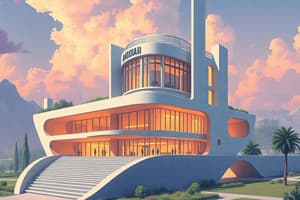Podcast
Questions and Answers
What does Modern Architecture strive for?
What does Modern Architecture strive for?
- Change and modernization (correct)
- Conformity to academic tradition
- Avoidance of mechanization
- Rejection of rational thought
What term was coined in Platz's publication 'The Architecture of the New Age'?
What term was coined in Platz's publication 'The Architecture of the New Age'?
Zeitgeist
Which material began to replace cast and wrought iron in construction due to its strength and cost?
Which material began to replace cast and wrought iron in construction due to its strength and cost?
- Steel (correct)
- Aluminum
- Plastic
- Copper
What architectural style does Soane's design for the Bank of England lean towards?
What architectural style does Soane's design for the Bank of England lean towards?
The Bank of England was built to raise funds for the government to wage war against _____.
The Bank of England was built to raise funds for the government to wage war against _____.
The Great Chicago Fire and economic depression caused a decline in building activities.
The Great Chicago Fire and economic depression caused a decline in building activities.
What was a major focus of Schinkel's Bauakademie in Berlin?
What was a major focus of Schinkel's Bauakademie in Berlin?
Match the following architectural concepts with their descriptions:
Match the following architectural concepts with their descriptions:
Flashcards are hidden until you start studying
Study Notes
Modern Architecture
- Emerged in the 20th century, aiming for change and reflecting contemporary societal values.
- Architects viewed as visionaries, interpreting the spirit of their era.
- Rejection of academic traditions in favor of rational thought and mechanization.
- Platz’s publication, "The Architecture of the New Age," coined the term "Zeitgeist," representing the spirit of the age.
- Zeitgeist embodies aspirations from Art Nouveau, encapsulating modernity and historical achievements.
- Post-WWI focus shifted to using architecture for societal transformation.
Eclecticism and Industrialization
- Eclecticism embraces diverse architectural styles and theories, avoiding rigid adherence to a single approach.
- Industrial advancements shifted reliance from manual labor to machinery.
- Wrought iron utilized for construction due to its strength and fire resistance.
- Steel became predominant, surpassing iron in strength and cost-effectiveness.
- The Great Chicago Fire and the economic depression spurred a construction boom and a new architectural culture.
- Innovations like the Steel Frame and Elevator revolutionized building design and function.
Soane, Bank of England, London (1788-1837)
- Social aspect blends neoclassical elements with modernization in architectural interpretation.
- Individual rooms reinterpret classical design, featuring rich volumes and simplified ornamentation.
- Design includes majestic vaulted spaces with elevated natural light, reminiscent of sacred spaces reinforcing the monetary transfer’s sanctity.
- The Tivoli Corner functions as a symbolic space, featuring heavy neoclassical columns and open sky above, dedicated to London’s citizens.
- Constructed to finance the British government’s military efforts against France, symbolizing national pride.
- A facade encapsulates various micro-buildings, reflecting a "City within a City" concept.
- The building represents England’s economic strength regarding capital and financial transactions.
- Includes a bronze statue symbolizing the dynamic spirit of the Bank, embodying credit and trust.
Schinkel, Bauakademie, Berlin (1832-35)
- Functioned as an educational institution for aspiring master builders, integrating shops, classrooms, and administrative spaces.
- Unique red brick cube design contrasted with Berlin's urban planning.
- Variation in floor designs emphasized different architectural forms tied to fundamental units.
- Schinkel sought to articulate a contemporary German architectural style amid national disunity post-Napoleon's invasions.
- Technological transitions were marked by a shift to brick, emphasizing the logic of construction.
- Utilized ornamental elements influenced by Classical and Gothic designs, balanced by modern factory aesthetics.
- Marked the transition from traditional masonry to iron-framed skeleton construction, advocating for architecture’s logical evolution.
Studying That Suits You
Use AI to generate personalized quizzes and flashcards to suit your learning preferences.





